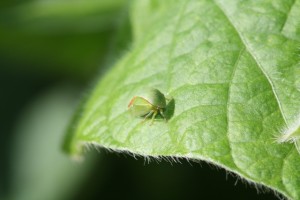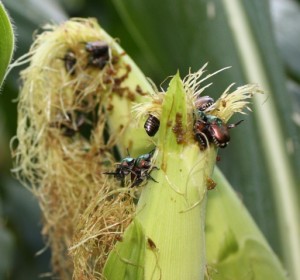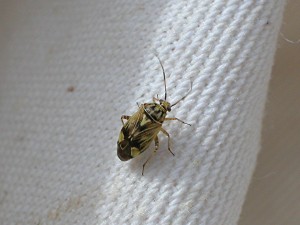Threecornered alfalfa hoppers, snails, Japanese beetles, and plant bugs … should you be worried? I’ve had a variety of calls this week, but the most frequent call has been about threecornered alfalfa hopper (TCAH). Surprisingly, many of these call have been on cotton.

TCAH is a very rare pest of cotton. It feeds similarly in cotton or soybean by girdling stems or leaf petioles. Thus, there will circular feeding ring around the stems (i.e., the girdle). My observations are that most girdling in cotton, like soybean, happens when plants are less than 5-6 nodes tall. The girdled feeding site often becomes swollen over time. The leaves and the stem of cotton seedlings with a main-stem girdle will turn crimson red. Injured plants typically quite growing and ultimately die, so think about TCAH if you see stunted, red-colored plants in amongst normal plants. This is more commonly seen on field edges. TCAH only causes problems if the level of damage is unusually high and/or the plant stand is already very low. Cotton is very good for compensating for the loss of a neighboring plant. The moral of this story is don’t get excited.

In soybeans, girdled seedlings may break over much later in the season when there is less time for neighboring plants to compensate. Thus, you should scout and treat for TCAH as needed when plants are less than 8-10 inches tall. The yield of girdled plants will not be affected unless they break over. This lodging is hard to predict but tends to be worse where stands are already thin. TCAH are relatively easy to control with Acephate/Orthene or pyrethroid insecticides, but they are sometimes very good at quickly re-infesting fields.

I’ve also had several calls about snails on seedling cotton or soybean. This is of little or no concern. Unlike slugs, snails do minimal plant feeding. It would have to be an extraordinary situation to justify treatment, and regardless, there are really no effective treatments options. The snails are simply stuck in the field and utilize the plants to get out of the sun, but they may scrape on a few leaves get a drink. This picture was texted to me by a concerned client. I understand why this would catch your attention, but there is nothing to worry about.

Japanese beetles are out and about in variable numbers, depending upon your location. This always generates some phone calls because they are quite visible and often occur in clusters. Japanese beetles will feed on the foliage or flowers of many plants including cotton and soybean. They also feed on the silks of corn. I’ve never seen enough feeding in cotton to justify treatment. Occasionally, they may do enough leaf feeding in soybean to cause concern, especially in combination with other defoliators. Remember, however, that soybean can tolerate a fair amount of leaf feeding. Prior to flowering, treatment is not recommended in soybean until at least 30% defoliation occurs throughout the canopy. Silk feeding on corn is primarily a concern under stress conditions that may cause poor pollination. Frankly, unless plants are under drought stress during pollination, our data suggests Japanese beetles will not cause economic damage. UT research would support the generally accepted threshold of treating for Japanese beetles when populations AVERAGE 3 or more beetles per ear during the first 5-7 days of silking. It is very unusual to see this many beetles across a field, but infestations tend to be much higher on edges. There is no point in treating for this pest after pollination has occurred. Pyrethroid insecticides such as Baythroid XL, Brigade, Declare, Mustang Max, and Karate are typically used if treatment is needed.

It is time to be alert for tarnished plant bug which is a much more serious and consistent threat to cotton. It’s early, but infestation levels appear pretty typical for this time of year (= highly variable). Please revisit last week’s article about managing early season plant bugs. I strongly discourage the use of Acephate prior to flowering. It’s bad resistance management, a good way to flare spider mite or aphid infestations, and not really needed. It’s a bad idea, so don’t ask my permission! Also remember that, according to label restrictions, Bidrin cannot be used between first square and first flower.

